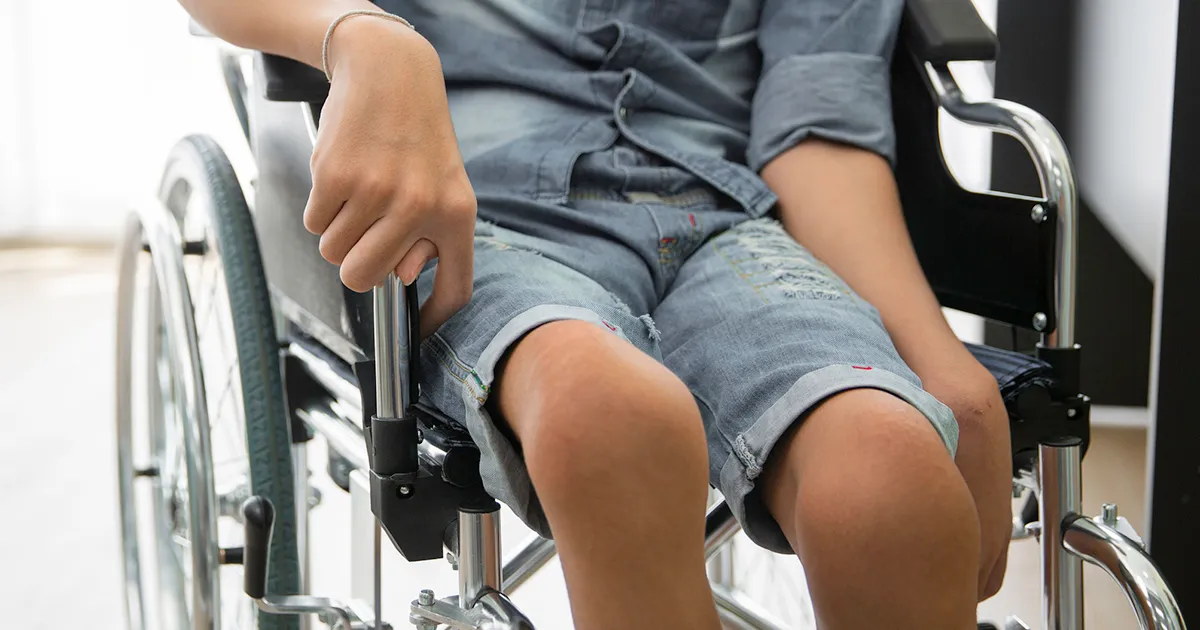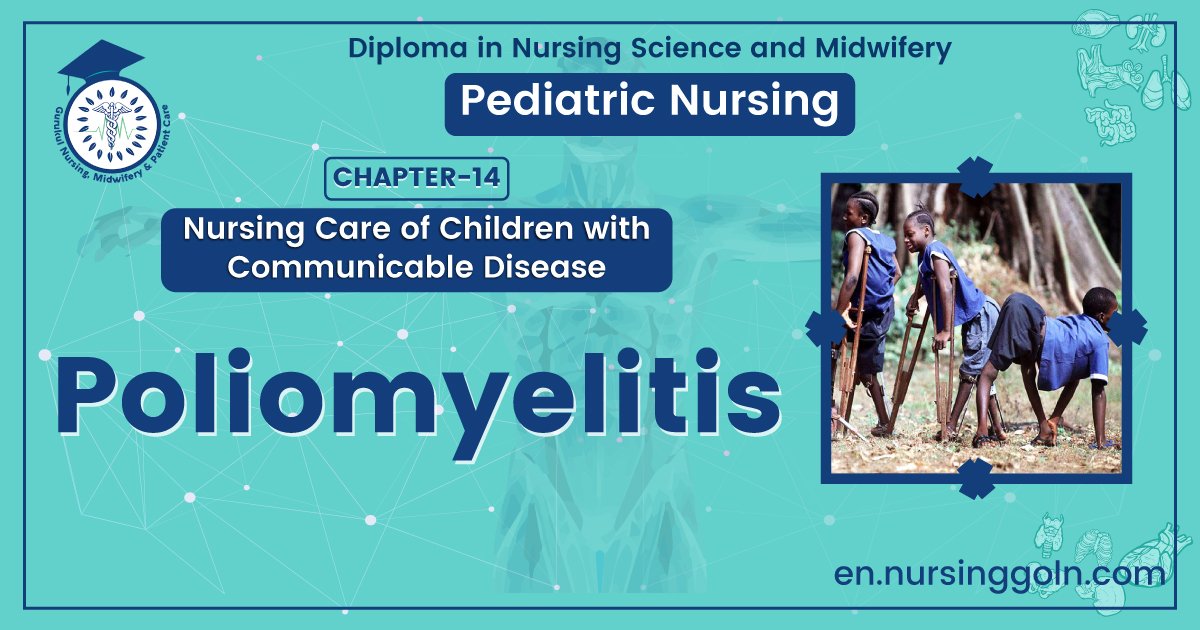Concept about Poliomyelitis – Health of the children has been considered as the vital importance to all societies because children are the basic resource for the future of humankind. Nursing care of children is concerned for both the health of the children and for the illnesses that affect their growth and development. The increasing complexity of medical and nursing science has created a need for special area of child care, i.e. pediatric nursing.
Pediatric nursing is the specialized area of nursing practice concerning the care of children during wellness and illness. It includes preventive, promotive, curative and rehabilitative care of children. It emphasizes on all round development of body, mind and spirit of the growing individual. Thus, pediatric nursing involves in giving assistance, care and support to the growing and developing children to achieve their individual potential for functioning with fullest capacity.
Concept about Poliomyelitis

Poliomyelitis:
It is an acute viral infection caused by an RNA virus affecting the central nervous system and infrequently resulting in paralysis. It is characterized by fever, malaise, headache stiffness of neck and back with increased cells and protein in CSF.
Polio is an acute viral illness that in its most severe from causes paralysis, difficulty breathing and sometimes death.
Epidemiological Features:
A) Occurrence: Its occurrence is worldwide. It can occur sporadically, endemically or epidemically.
B) Ecological triad:
a) Agent factor:
- Agent: The causative organism is the poliovirus which has the three serotypes 1, 2, 3 most out breaks of paralytic polio are due to type-1 virus
- Reservoir of infection: Man is the only known reservoir of poliomyelitis.
- Infectious material: The viruses are found in the faeces and oro-pharyngeal secretions of an infected person.
- Period of communicability: The cases are most infectious 7-10 days before and after onset of symptoms.
b) Host factors:
- Age: Most cases occur in children aged around 5-7 years. Only a few cases occur in adults.
- Sex: Males more among children and female more preponderance among adult patient
- Immunity: One attack gives a lifelong lasting immunity
C) Environmental factors: More likely in summer month. Infection rate is influenced by environmental sanitation.
D) Natural history:
a) Incubation period: Usually 7-10 days
b) Mode of transmission:
- Fecal-oral route: Directly through contaminated fingers where hygiene is poor and indirectly through contaminated water, milk, foods, flies, and articles of daily use.
- Droplet infection
Pathogenesis of Poliomyelitis
1. Causative agent; Polio virus.
2. Transmission; Faeco-oral route (by ingestion of contaminated food & drink).
3. Incubation period; 7 to 10 days.
4. Pathogenesis;
Polio virus
↓
Enter into the body by faeco-oral route
↓
Multiplies in the lymphoid tissue in the oropharynx & small intestine (Peyer’s patches)
↓
Go to the CNS (spinal cord & brain) via blood stream and also by retrograde spreading along nerve axons.
↓
Replicates in the motor neurons of anterior horn of the spinal cord.
↓
Death of the nerve cells.
↓
Paralysis of the muscles innervated by those neurons.
The virus also affects the brain stem, leading to bulbar poliomyelitis (with respiratory paralysis), but rarely damage the cerebral cortex.
[Ref by- LANGE review/15th/323,324]

Clinical Features:
A) In-apparent, asymptomatic infection: Occurs in 90-95% cases.
B) Abortive illness: Occurs in 4-8% cases. It is the most common clinical form which is a mild febrile illness characterized by
- Headache
- Sore throat
- Nausea
- Vomiting
C) Non paralytic polio: Occurs in approximately 1% of cases. It is manifested by
- Fever
- Headache
- Neck stiffness
- Sings of meningitis
D) Paralytic polio: Occurs in 1-2% cases asymmetrical flaccid paralysis deep absent without sensory lose.
Treatments:
No cure for polio exists, the focus is on increasing comfort, speeding recovery and preventing complication. Supportive treatments include:
- Bed rest
- Antibiotics for secondary infection (if any)
- Analgesics for Pain
- Portable ventilators to assist breathing
- Physiotherapy to prevent deformity and loss of muscle function
- A nutritious diet
Prevention and Control:
Active immunization to all children with polio vaccine (OPV or Sabin vaccine)
A. Live Attenuated vaccine (Sabin):
Dose schedule-
- 1st-at birth
- 2nd – 6 weeks later after birth
- 3rd- 10 weeks later after birth
- 4th – 14 weeks later after birth
- 5th- 9 months of birth
B. Inactivated or killed vaccine (Salk):
- At first 3 doses are given intervals at of 1-2 months and 4 ^ (fh) dose 6-12 months after that.
C. Others
- Reporting of cases of paralytic poliomyelitis
- Disinfection of contaminated articles
- Improving public sanitation
- Careful personal hygiene
- Isolation of cases
[Ref by- LANGE review / 15 ^ (4h) / 324 + EPI schedule]
Types of Polio Vaccine:
1. Injectable polio vaccine (IPV) or Salk vaccine or killed polio vaccine.
2. Oral polio vaccine (OPV) or Sabin vaccine or live-attenuated polio vaccine.
[Ref by- LANGE review / 13 ^ d / 324 * l
Merits (advantages) of Live Attenuated Vaccine (Sabin vaccine) or. Oral polio vaccine:
1. Cheaper.
2. Easy to administer.
3. Produce local gut immunity by provoking production of intestinal IgA.
4. It has also effects on the environment by displacing the wild variety by contamination.
5. Longer duration of immunity.

Demerits (Disadvantages) of Live Attenuated Vaccine (Sabin vaccine):
1. It may revert to virulence.
2. It can also spread from vaccine to contacts.
3. Presence of other viruses may interfere with gut colonization.
4. Cannot be given in pregnancy & immunosuppressed persons.
5. Multiple doses are necessary to establish immunity.
6. Must be kept refrigerated to prevent heat-inactivation.
Advantages of Killed/Injectable/Salk Polio Vaccine;
1. No virulence.
2. No chance of spread.
3. Can be given in pregnancy and immunosuppressed persons.
4. No need of refrigeration.
Disadvantages of killed / injectable / Salk polio vaccine
1. Not produces local gut immunity.
2. Not interrupts transmission of wild viruses.
3. No secondary protection to others.
4. Shorter duration of immunity.
Factors Favoring Eradication of Polio:
1. Man is the only host
2. No long term carrier state
3. OPV is easy to administration
4. OPV is cheap
5. Live attenuated viruses in OPV multiply in intestine and interrupt the transmission of wild viruses
6. OPV induces both humoral and intestinal immunity
7. Antibody is quickly produced
8. Viruses can be transmitted from a recently vaccinated child to close contacts who has not immunized
9. No insect vector or animal is involved in the transmission of the disease
10. Having international cooperation
Nursing Management of Poliomyelitis;
No specific treatment is available for poliomyelitis. The prompt symptomatic and supportive management help in good prognosis. Good nursing care plays vital role for recovery and better
outcome. Koush
1. Hospitalization is necessary for all paralytic polio cases.
2. Strict bed rest preferably on hard bed with minimum and gentle handling of the affected part are very essential.
3. Positioning of the patient to be done to keep the airway patent and head to be turned to one side for gravity drainage of oropharyngeal secretions.
4. Analgesics may be administered to relief pain.
5. Hot moist pack or dry heat with infrared lamp or hot tub bath may be useful to reduce pain of the affected part.
6. Antihypertensive drugs may be needed in some cases.
7. Mild sedative tranquilizer may be given in spinal paralysis to relief anxiety.
8. In case of respiratory failure, the patient should be managed in ICU with assisted ventilation in the mechanical ventilator.
9. Maintenance of fluid-electrolyte balances are very important in acute phase of illness.
10. When muscle pain and spasm is relieved, then full range passive physiotherapy should be provided to prevent deformities and promote muscle power.
11. Rehabilitation of the paralyzed child should be planned according to the degree of involvement.
Eradication:-
Eradication of disease implies termination of all transmission of infection by extermination of the infectious agent is called eradication. eg. Small pox is the only disease that has been eradicated.

Polio eradication programmed in Bangladesh:
The university child summit of 1988 adopted a resolution to eradicate poliomyelitis from the world by the years 2000. Eradication of poliomyelitis is a global programmed and the strategies recommended by WHO to achieve the goal of eradication are-
- Achieving and maintaining high immunization coverage.
- Reporting and investigation all acute paralysis cases among children (Polio suspect)
- Conducting supplementary immunization which includes case reporting mopping up and national immunization day (NID).
NID is supplementary vaccination strategy aiming at interruption of transmission of poliomyelitis. NID means vaccination simultaneously throughout the country with OPV of all children less than five years, repeated twice, with four to six weeks interval. This helps to establish vaccine virus in the community in place of wild polio virus.
Read more:
